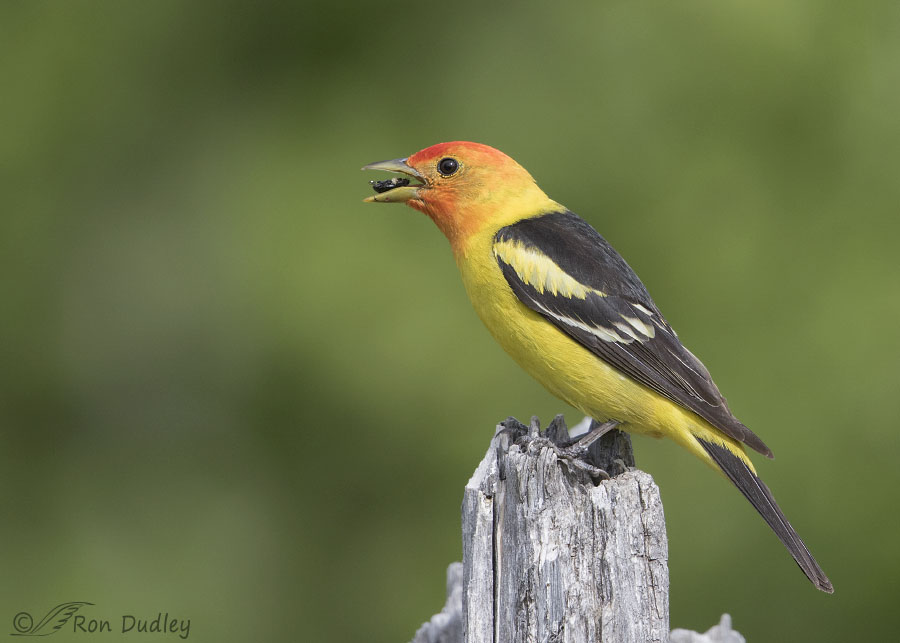A shorter post today. After yesterday’s very long one I decided to give both my readers and myself a break.

1/1600, f/6.3, ISO 800, Canon 7D Mark II, Canon EF 500mm f/4L IS II USM + EF 1.4 III Extender, not baited, set up or called in
The tanagers I’ve been photographing in my campsite usually hawked insects from the surrounding trees where they were difficult to photograph well. But occasionally one of them would land on this stump that was out in the open and then proceed to hunt for insects on the ground beneath it. Sometimes they’d return to the stump to eat it and sometimes they wouldn’t. This time this one did.
They often manipulated their insect prey in their bills for quite a while before gulping it down and I wondered why. Most birds I’ve observed swallow insects much more quickly.

Then I realized they were often eating hard-shelled beetles. Perhaps they were cracking the exoskeleton and tasting their snack before swallowing but that’s only a wild guess.
Yes, I’ve been posting a lot of tanagers lately but on this trip they’ve been my most cooperative birds. Besides I’ve never had this much luck with them before so they have my attention at the moment.
Ron
Note: I realize that beetles aren’t really “bugs”. Only those insects in order Hemiptera are true bugs and that doesn’t include beetles. Even the ladybug isn’t really a bug. But in this context bug just sounded better to me so I went with it.


Beautiful photos of a gorgeous bird! I have seen and photographed a Western Tanager in East Haven,CT (2 or 3 years ago), amazing! As for eating bugs, I love all of the birds that eat bugs, less for me to see and/or get bit by.
Bug is fine — unless it’s on your phone.
These tanagers are GORGEOUS!!!
I agree with many of your fans about the word bug. I don’t need to have the classified. Beautiful bird pictures are never tiresome. Enjoy your trip.
As other have said, I would take a while to actually swallow that beastie as well.
I am thrilled with your tanager series. Yet another beauty I will not see for myself. Thank you.
How is your back? Better I hope.
Now that closeup is an excellent photo. Every feather sharp and clear. Congratulations!
That is one beautiful bird you have posted, and almost looks like a painting. Any type of crawling, flying little critter is a “bug” to me! Enjoy your time in Idaho and Montana. Beautiful time of the year.
Maybe they need to get the head down the gullet first, just like a snake?
Perhaps he is savoring his catch, the taste, texture,
or just playing with his food. Maybe a new bug for him. Only the Tanager knows. Such a great closeup; two eyerings, feather “layering” below the eye.
That is a beautiful photo of a very colorful bird. And to get it on that stump with no twigs, branches, leaves, etc, is perfection. And bug is fine for the beetle for me Ron. Not being an entomologist or even a biologist like you, a beetle will always be a bug to me:) Reading Diane’s post above reminds me how much I miss dogwood. I have been living in the west now for 41 years, but one of the things I miss most about growing up in suburban Philadelphia is the dogwoods in the spring.
Everett Sanborn, Prescott AZ
Sensational shots Ron! Thanks for sharing this beautiful bird.
Charlotte
Thank you, Charlotte.
Great photo; especially like the closeup showing the details surrounding his eye…looks like little beads of yellow. Another bird belonging to the smooth, glossy feather clan! Hope your excursion into the wild has been good. Side note…the oozy goo of the beetle just didn’t go with my coffee this a.m. …not your typical filled morning delicacy!
…not your typical filled morning delicacy!
Ha, just think of it as thick cream for your coffee, Kathy!
“Bug” works for me! Makes sense that they would crack the shell to ease digestion (and make sure they were dead) besides “tasting” to make sure they really wanted to eat it!
Makes sense that they would crack the shell to ease digestion (and make sure they were dead) besides “tasting” to make sure they really wanted to eat it!  Beautiful bird! How’s the back doing?
Beautiful bird! How’s the back doing?
Good point about cracking the shell to ease digestion, Judy. The back is about the same but I’m coping.
Great photos. I know you’ve posted several photos of Western Tanagers lately, but how could anyone ever tire of seeing them?
The exoskeletons of the beetles would likely be broken up by the gizzard (rear portion of the stomach) but the primary digestion of insects will take place in the forward portion of the stomach (proventriculus) before reaching the gizzard. By macerating and cracking the exoskeleton by the beak, digestion will be more efficient. This process would be more important when eating beetles with thicker, harder shells, which is true of many ground-dwelling beetles.
Love the Western Tanagers you’ve been posting lately! This April I had a male hanging out in my dogwood for four days- which was really unexpected since I live in St. Louis, 600 miles east of its expected range! Over 100 birders came to catch a glimpse of him as he worked over the blooming dogwood and visited the suet feeder. He was the 10th state record, a true joy to watch!
There’s nothing like a rare bird to get a birder’s juices flowing, is there. In your own yard too!
If I had that in my mouth, I’d probably spend a lot of time checking it out before I swallowed it, too!
Good point, Allison.